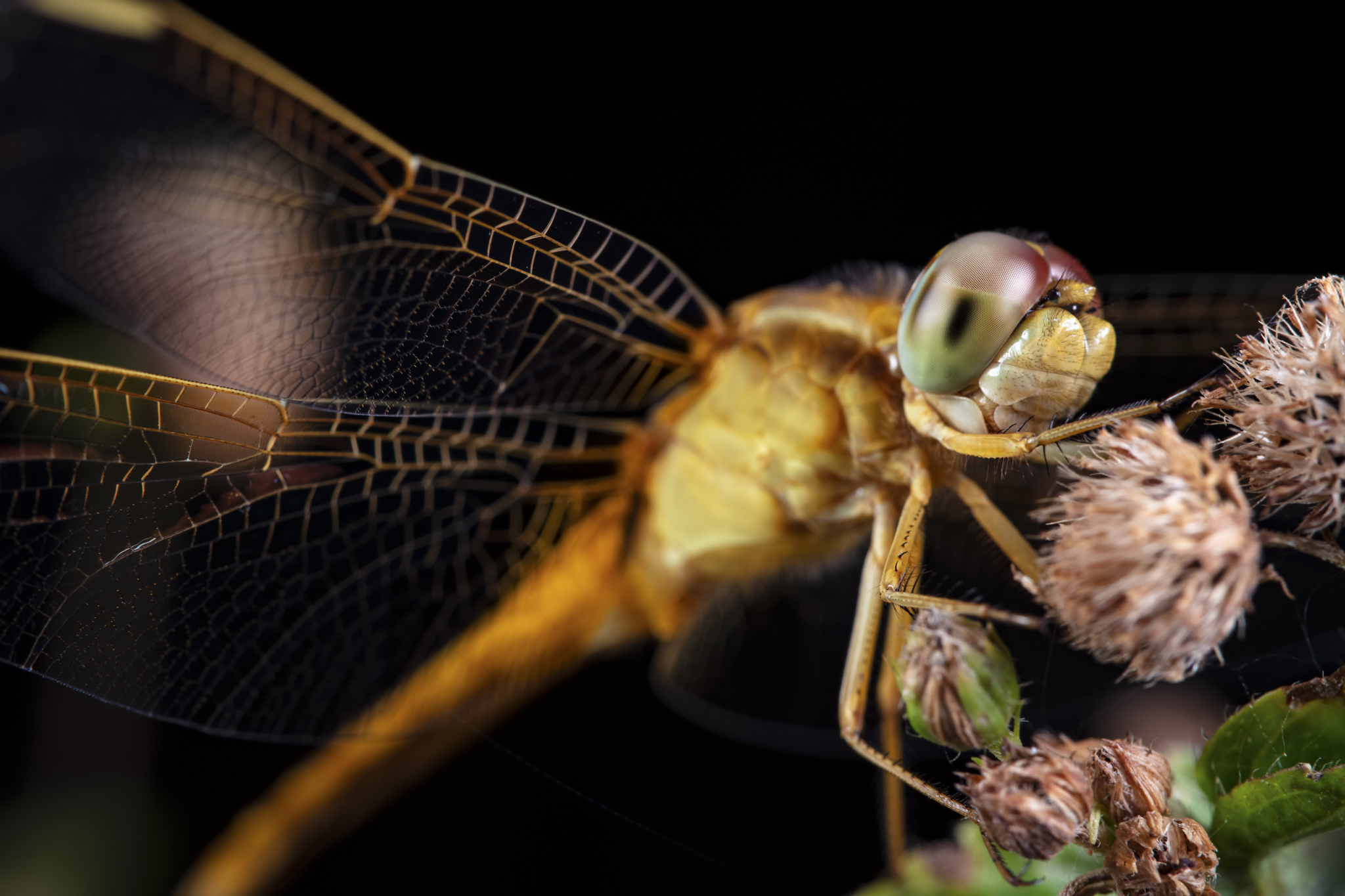Night Dragons of Yomitan
Nocturnal Macro Photography, many times over less stressful than chasing bugs around during daylight hours!
Have you ever spent a few hours in the daylight chasing after bugs trying to satisfy your macro photography craving? Stressful as hell isn't it? I'm pretty sure it's that frustration that led to me being somewhat follicly challenged at this time in my life. I mean trying to stalk hyperactive and extremely skittish winged insects around any green area is an invite to premature baldness!

The detail of a Dragonfly's eye at night, the only time they are calm enough to allow me to get up close and personal.
I'd spent the past hour in the late afternoon walking around the irrigation ditches of some farmland close to my apartment when I was just about ready to give up. I guess I was starting to twitch and emit psychotic giggles akin to Inspector Dreyfus in the Pink Panther movies. This was driving me bananas. I'd been trying to chase down a Wandering Glider, a species of Dragonfly that seemed to be out in great numbers. But could I get close? Not a chance. Well there was one time when I thought I was about to nail the shot when the movement of my shutter finger was sufficient enough to scare the bug away. And thus I started all over again.
After dark, I'd gone home by now swearing I was done with Dragonflies for now, I thought I'd give it one more bash. I'd been fortunate enough with shooting Dragonflies after dark before, maybe this approach would yield better results. It wasn't long before I found my one and only model.
Alone on the broad leaf of an Aloe plant I spied my quarry. Not wanting to scare it off I switched on my Canon EOS5DSr and fired up my KX800 twin macro speed-light from Laowa. I was also using the Laowa 60mm f2.8 2:1 macro to get that little bit closer if the critter would allow it. Well at night it seems most things are drowsy or sleeping. I took a test shot to get all the settings sorted and started on my approach. Slowly does it.
It felt like an age but I eventually got into place. I'd made my approached over a ten minute period that felt like days, I had wiggled myself to within a few inches of the Dragonfly, it filled my viewfinder at 1.4:1 macro ratio. I had my ISO set to 100, my shutter at 1/160th given I was limited to 1/200sec synch speed with my Canon all rounded out at an aperture setting of f8. I took the shot. It fled! I thought I'd lost the shot but luckily the critter had transitioned to a plant just a few meters from its original perch.
I started my second approach. The image disappeared from my viewfinder as the camera wrote the image to the memory card. Man it was a keeper. Even with the shallow depth of field due to the proximity of the shot there were enough elements in the image that were more than acceptable.
To see a larger image of this simply click on the small circular icon with the opposing arrows in the top right corner of this page when you scroll to the top. Click a second time to return to the standard page view.
“There is a pleasure in the pathless woods,
There is a rapture on the lonely shore,
There is society, where none intrudes,
By the deep sea, and music in its roar:
I love not man the less, but Nature more”
Lord Byron
About the Author
Internationally recognized as a provider of quality mixed media Mark Thorpe is always on the search for captivating content.

Photographer / Cameraman
Mark Thorpe
Emmy Award Winning wildlife cameraman and Internationally published landscape photographer Mark Thorpe has been an adventurer since he could walk! Spending 17yrs as an Underwater Cameraman at the start of his imaging career the highlight of which was being contracted to work with National Geographic. In that role as a field producer and cameraman he's been privy to a mixed bag of hair raising adventures. For some reason he was always selected for projects relating to large toothed marine predators such as Great White and Tiger Sharks, Sperm Whales and Fur Seals. Additionally he has also been active within Southern Africa on terrestrial projects dealing with a wide array of iconic wildlife.
Currently based in Okinawa, Japan he's always on the lookout for his next big adventure. He shares his exploits online with a totally organic social audience in excess of 200,000. Sponsored by a number of photographic industry manufacturers he is constantly scouring the islands for captivating landscape and oceanscape compositions. Videography wise he continues to create short photographic tutorial videos as well as creating content about the diversity of wildlife within Okinawa and the Ryukyu Islands of Southern Japan.
Mark has just created a Patreon channel where he's hoping to raise an audience of supporters who through small monthly shows of appreciation will allow him to concentrate on the creation of a wildlife and landscape imaging themed YouTube Channel. If you feel that is something you'd like to support you can visit his Patreon Channel for more information.
